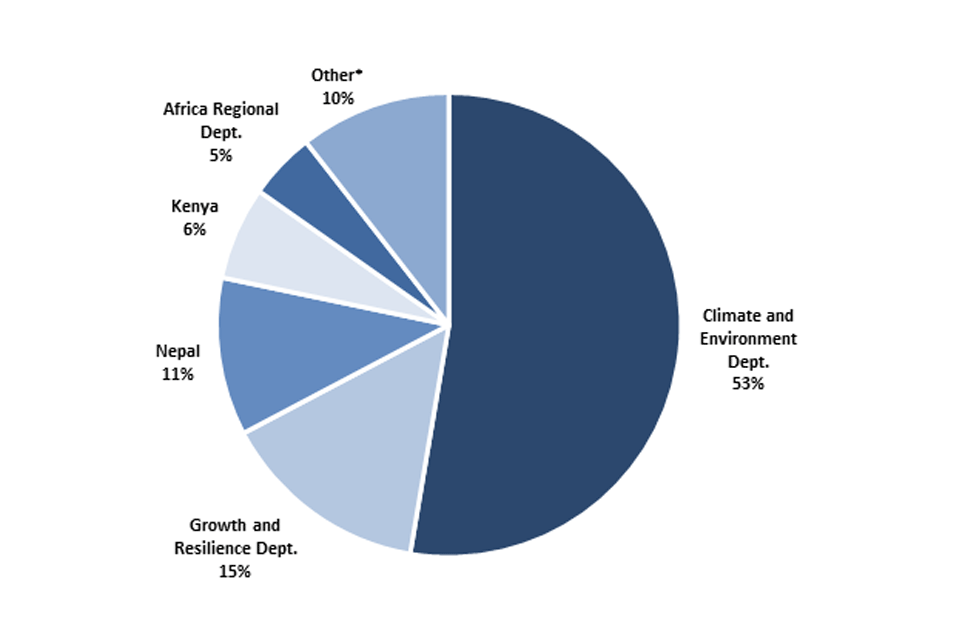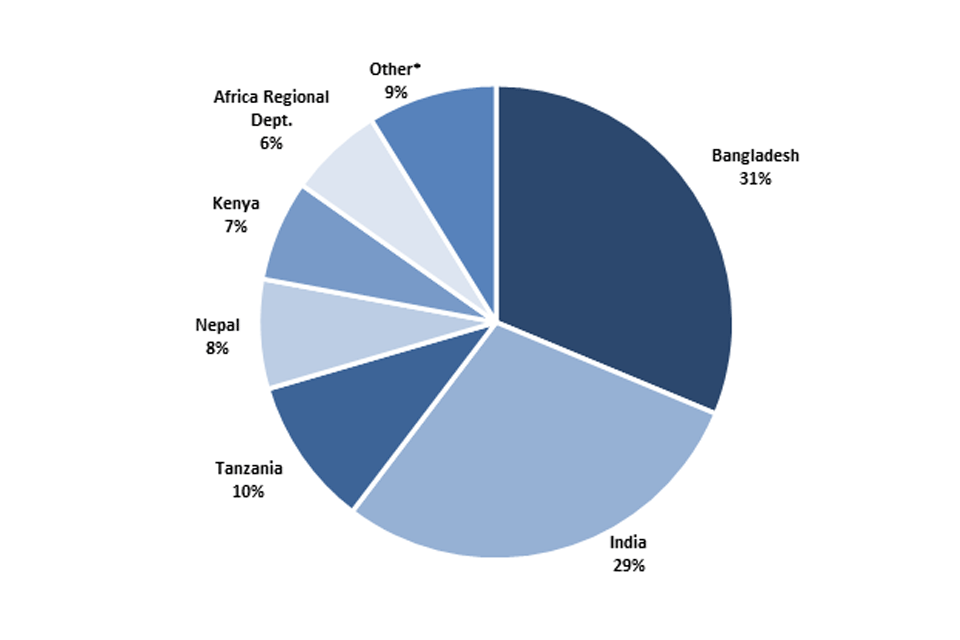DFID Annual Report and Accounts 2014 to 15 Results achieved by sector: Climate Change
Published 16 July 2015
Climate change will have the greatest impact on the poorest in the developing world and many poor people already suffer the effects of extreme weather events. Tackling climate change and promoting sustainable growth and development are necessary to eliminate poverty: one cannot be achieved without the other.
Climate change causes changes to precipitation, temperature and sea level rise. These changes may be sudden onset or gradual, and can include floods, droughts, storms, landslides, salination, coastal inundation, heat or cold waves and biodiversity loss. Poor people need support to adapt their lives and livelihoods to cope with the impacts of climate change. For example, climate change means that farmers will need to use crops that can cope with more frequent droughts, and that homes, schools and hospitals will need to be built to withstand more extreme weather, such as floods.
Energy access is crucial to development and poverty reduction by enabling better education, communication, refrigeration and access to information. Cleaner or more efficient cook stoves also have health and time saving co-benefits. This is particularly the case for women and children who are often affected more from the negative impact of indoor air pollution and have to spend time collecting fuel wood. Clean energy should also partly displace fossil fuels (such as kerosene for lighting or diesel generators) resulting in lower carbon emissions and reduced deforestation caused by use of non-renewable biomass for fuel. Around 1.2 billion of the world’s poor people depend on forests for their livelihoods. The aims of the UK’s forestry support are to reduce greenhouse gas emissions from the forest sector, preserve bio-diversity and tackle poverty by reducing deforestation and forest degradation, helping protect livelihoods.
The climate change indicators in the DRF are a subset of indicators that DFID is using which have already informed the development of multilateral and UK government results frameworks including the Climate Investment Funds and the Green Climate Fund. Most of DFID’s results have been provided through the International Climate Fund (ICF), a cross HMG fund of £3.87 billion between 2011 and 2016. The ICF aims to demonstrate that low carbon, climate resilient growth at scale is feasible and desirable and finances projects bilaterally and via multilateral institutions. The Independent Commission for Aid Impact (ICAI) recently concluded that the ICF ‘has pioneered new approaches in the measurement of results’ and confirmed that the ICF is well placed to deliver on its ambitious objectives, and is having a substantial impact galvanising global action on climate change.
The indicators reflect how we are helping poor people adapt to the impacts of climate change, promote low-carbon growth and protect forests in developing countries. In doing so these programmes tackle climate change, improve the quality of people’s lives, and underpin sustainable economic growth and development.
1. DFID commitment
DFID has made a commitment to:
- help millions of poor people to protect their lives and livelihoods from the effects of climate change
- help millions of poor people secure clean energy
- give more protection to the world’s forests and the 1.2 billion people who depend on them
2. Indicators used to measure progress
There are 3 climate change indicators included in the DFID Results Framework to measure progress towards the climate change commitment:
- number of people supported by DFID funding to cope with the effects of climate change
This indicator seeks to measure the numbers of people who have received support to prepare and equip them to cope with the effects of climate change; support received can include financial resources, assets, agricultural inputs, training, communications (e.g. early warning systems), and information (e.g. weather forecasting).
- number of people with improved access to clean energy as a result of DFID support
This indicator seeks to measure the number of people with improved access to clean energy which includes new connections to off-grid renewable energy sources and households with more efficient cook stoves, solar lanterns or other clean technologies which generate energy.
- number of hectares where deforestation and degradation have been avoided through DFID support
This indicator will provide a broad measure of success against the headline forestry outcome of reduced deforestation and degradation of the world’s forest land.
3. Results achieved
By 2014-15, DFID had achieved the following results against the indicators set out above:
- supported 14.6 million people to cope with the effects of climate change
- improved access to clean energy for 4.9 million people
- avoided approximately 8,000 hectares of deforestation and degradation
Results are delivered through a range of projects, for example:
- The Nepal Climate Change Support Programme responds to Nepal’s need for support for its National Adaptation Programme of Action. The programme builds the Government’s capacity and establishes systems and processes to effectively address climate adaptation. It funds community-based climate resilient development initiatives in agriculture, water, energy, forestry and disaster risk reduction, with a focus on gender. This programme has already supported nearly 300,000 people, over half of whom are girls and women, to cope with the effects of climate change and this is expected to be doubled to approximately 600,000 by the end of the programme.
- The Green Mini-Grids Africa programme in Kenya and Tanzania aims to support decentralised access to electricity and includes a clear focus on enabling girls and women to gain skills and access jobs in mini-grids delivery, as well as participating in the benefits of rural electrification.
As well as directly targeting forestry and low carbon energy and supporting people to cope with the effects of climate change, DFID is looking at other ways it can have a transformational impact. This includes leveraging finance from private institutions as well as other country governments. This allows the UK to mobilise the maximum amount of private and public sector money for each £1 it spends and reflects the undertaking at the UN conferences in Copenhagen and Cancun to mobilise $100 billion per year for climate finance.
4. Progress towards DFID results commitments
Results achieved up to 2014-15 inclusive
| Indicator | Indicator type | Results commitment | Male | Female | Not identified | Total |
|---|---|---|---|---|---|---|
| Number of people supported by DFID funding to cope with the effects of climate change | Cumulative | No specific target | 2,250,000 | 2,240,000 | 10,100,000 | 14,600,000 |
| Number of people with improved access to clean energy as a result of DFID funding | Cumulative | No specific target | 2,060,000 | 2,020,000 | 810,000 | 4,900,000 |
| Number of hectares where deforestation and degradation have been avoided | Cumulative | No specific target | NA | NA | NA | 8,000 |
5. Results achieved by country/department
Other than programmes managed by centrally by DFID’s Climate and Environment Department and Growth and Resilience Department, Nepal and Kenya host two of DFID’s larger programmes which are directly supporting people to cope with the effects of climate change. Over a million people have been supported in Nepal with a similar number receiving support in Kenya.
In Bangladesh and India DFID has supported over 2.5 million people to access clean energy. In Tanzania almost half a million people have benefitted.
Nepal is the largest beneficiary of support from DFID for reducing the number of hectares of forest that have been deforested or degraded. 6,000 hectares of deforestation and degradation have been avoided with DFID support. The remaining 2,000 hectares of avoided deforestation and degradation were achieved in Rwanda.
5.1 Number of people supported by DFID funding to cope with the effects of climate change (by country/department)

Number of people supported by DFID funding to cope with the effects of climate change (by country/department)
5.2 Number of people with improved access to clean energy as a result of DFID funding (by country/department)

Number of people with improved access to clean energy as a result of DFID funding (by country/department)
6. Results achieved by multilateral organisations
There are no climate change multilateral results indicators in level 2 of the DRF.
